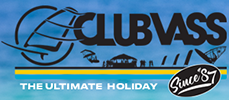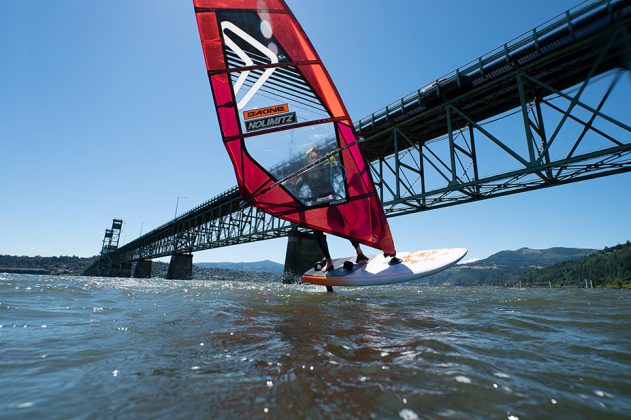If you are new to ‘flying’ on a foil then read on, as Wyatt Miller gives us tips for first time foiling.
Words Wyatt Miller // Photos Zaira Valerio (technique), Bryan Metcalf-Perez (action).
I teach windfoiling at my La Ventana windsurf centre, Pro-Windsurf La Ventana, Baja, Mexico every day. Most people are getting 50 metre flights on their first session. If you can jibe a normal windsurfer, you can learn to windfoil quickly. The crashes are nothing we haven’t all experienced a hundred times….and usually they happen at a much lower speed than we are used to. Here are my tips for getting started.
TWO PITFALLS OF THE FIRST TIME FOILER

Wrong – no windsurf stance allowed!
Don’t go out totally underpowered.
Wind foiling is for light wind…but only once you have some technique. When you first start out you want to have enough wind to get planing on your normal gear. For their first time, I send people out on a half metre smaller than they would use on a regular board. You can eliminate a lot of variables if you are not completely underpowered.
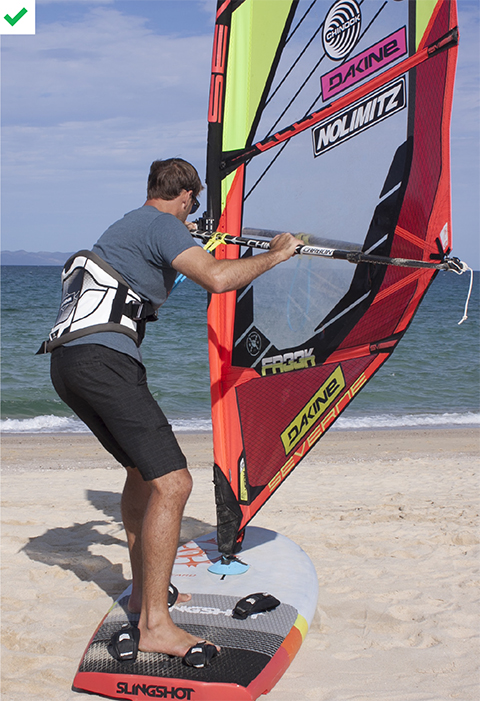
Correct – stand up, over the board, in foil stance with your foot pressure going to the bottom of the ocean.
Do not push against the foil mast, as if it were a regular fin.
The biggest problem I see with first time foilers is they push downwind, against the foil’s mast like they would their normal fin. Instead, all their foot pressure needs to be going straight down to the bottom of the ocean and into their front wing. Any pressure against the “fin” like a classic windsurfer will cause them to swing wildly upwind and downwind once they take flight.
If you lean out upwind over the water and into the harness like a classic windsurfer you will definitely be pushing downwind, across the board, against the “fin”. Instead, you need to stand straight up over your feet, keeping the harness lines taught and pressure in the sail, but you must not lean out over the water relying on your harness and sail for balance. Stand up straight over your feet!!! No matter how well someone understands the concept of not pushing downwind, across the board, against their “fin”, their years of windsurfing muscle memory will make them do it. It is a really hard habit to break.
“Wind foiling is for light wind…but only once you have some technique.”
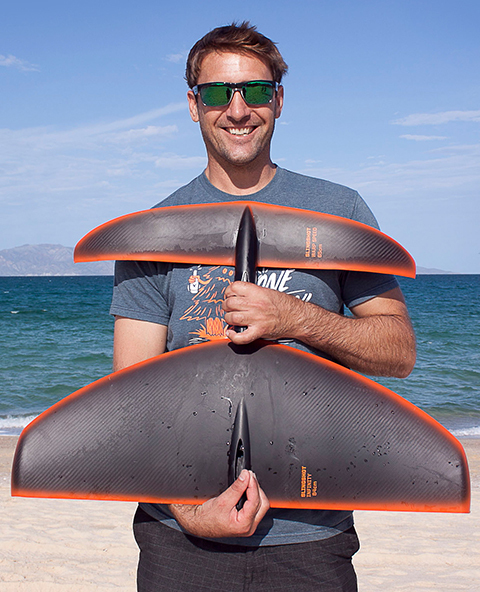
Drastically shorten your learning curve with a BIG low aspect wing.
NINE STEPS TO SUCCESS
• Big, large surface area, low aspect wings make everything easier….waaaay easier. Smaller, race oriented, high aspect wings are very twitchy side to side and quite unstable with a very high stall speed, if you slow down at all your board will drop to the water. Small race wings will slow your progress down by YEARS. I have people come to the centre who have been foiling for 3 years on high aspect race wings and have never completed a jibe. 2 sessions on a big, low aspect wing and they are foiling all the way through their jibes.
• Don’t kick your feet when you waterstart, that foil is everywhere you want to kick.
• The board is made to foil with your feet positioned in the straps. It will not lift if you are in a slogging stance with your front foot near the universal. Get up on the board and start moving, once you are comfortably slogging get into the front strap immediately, long before you ever try to get on the foil. Put your back foot in the middle of the board all the way back against the back straps. Remember the board is designed to lift with your back foot in the strap, so get it back there.
• Stand upright with all your foot pressure going to the bottom of the ocean. Make sure you have at least 60% of your weight on your front foot. Put tension in the sail, but do not lean back over the water, stay over your feet and gradually sheet in. Keep your head and chest forward over your front foot and give plenty of mast base pressure.
• Hooking into the harness helps keep things static, it is not necessary but it can help keep the rig in one position.
• Pick up speed by heading on a broad reach and concentrate on keeping the board as flat as possible. When you hit the take off speed it will lift. Bigger wings have a lower take off speed, more side to side stability, and make things much easier. Small wings are super twitchy and difficult.
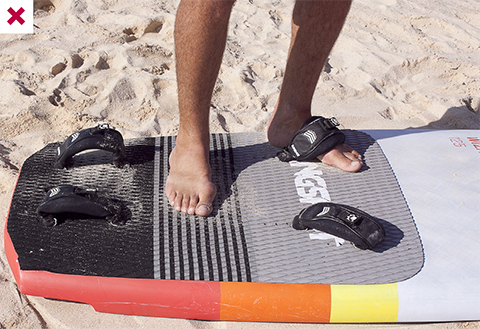
Wrong – back foot too far forward.
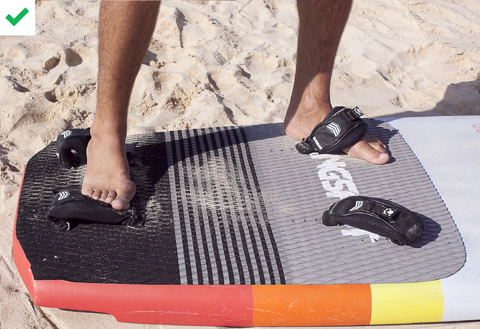
Correct – get your back foot in the strap, or at least touching the back strap.
• The problem is not getting it up…the problem is keeping it down. Once the board lifts, swing your hips forward to get pressure on the front foot, that will bring you back down towards the water.
• Pressure on your back foot will cause the board to lift, mast base pressure and pressure on your front foot will cause you to go down. You really need to move your hips forward for front foot pressure and back for back foot pressure, just trying to stomp pressure onto one foot or the other won’t do it. It’s all about moving the hips forward and back.
• Don’t hit the bottom! On your way out, flip the board upside down and swim it out until the water is over your head. On the way in, get off waaay before the water gets shallow. If you slam the foil into a rock you can do irreparable damage.

